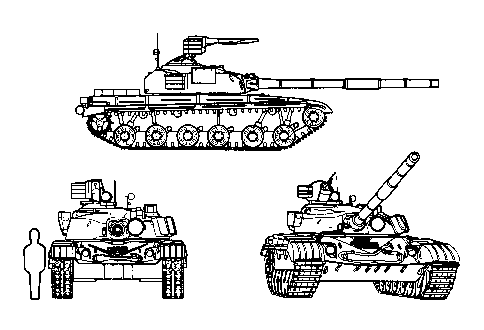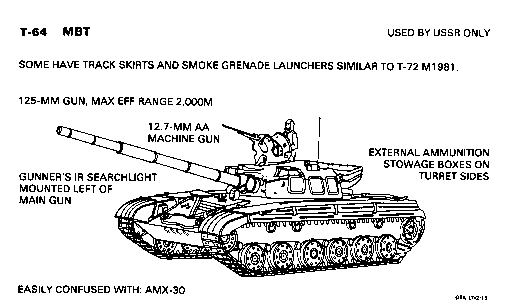



T-64 Tank
The T-64, introduced in the late 1960s, was the first of a sophisticated new family of Soviet main battle tanks developed as successors to the T-54/55/62 family. Retaining the low silhouette of the T-54/55/62 series of tanks, the T-64 featured an innovative design incorporating both an autoloader and advanced armor. The T-64 entered production in 1966, was fielded in 1967, and was first seen in public in 1970. Numerous variants were produced during a very long production run. While the T-64 is closely related to the T-72, the T-64 was produced solely for the Soviet Army and the slightly less capable T-72 was exported world-wide. Unlike the T-72, the T-64 has an infra-red searchlight on the left side of the 125mm gun, a different power pack, narrower track, a different suspension, and a slightly different turret.
DESCRIPTION:
The T-64 and the T-72 medium tanks are similar in general appearance. Both retain the low silhouette of earlier T-54/55/62 tanks. Both have a live track with six evenly-spaced road wheels, drive sprocket at the rear, and idler wheel at the front. The driver's hatch is centrally located at the top of a sharply sloped upper glacis, which has four steel ribs and a V-shaped water and debris deflector. The low-rounded turret is centered on the hull. The commander's cupola is located on the right side of the turret, and the gunner's hatch is on the left side. The 125-mm main gun has a four-section removable thermal shield, with two sections in front of and two sections to the rear of the mid-tube bore evacuator. A 7.62-mm coaxial machine gun is mounted to the right of the mantlet. Integrated fuel cells and stowage containers give a streamlined appearance to the fenders. A toothed shovel/ dozer blade is located at the front of the hull, beneath the glacis, and there are attachment points beneath the blade for the KMT-6 mine clearing plow. Early models sometimes mounted four detachable track protection plates on the front half of each side, while later versions have been observed with detachable full-length standoff skirting.
However, there are several design differences between the two tanks. Those features peculiar to the T-64 are as follows:
The T-64 has six small, stamped road wheels and four track return rollers. It has a 12-tooth drive sprocket and double-pin track.
The gunner's IR searchlight is mounted to the left of the main gun. The newly-designed 12.7-mm NSVT antiaircraft machine gun on the commander's cupola has a fixed mount and can be fired buttoned up. Several large external ammunition stowage boxes normally are attached to the sides of the turret. A long snorkel is stowed on the rear edge of the turret, and a second snorkel with an elbow for attachment to the engine exhaust is stowed inside the first.
The T-64 has a smaller engine compartment than the T-72, and the radiator grill is located near the turret.
The T-64K command variant has an additional whip antenna and a 10-meter antenna mast which can be erected in the center of the turret using guy wires. It employs the same TNA-3 land navigation system found in the T-62K command tank and mounts no antiaircraft machine gun.
CAPABILITIES:
The T-64 has greater mobility than the T-62. The 5-cyllinder, opposed-piston, diesel engine has an estimated output of 700 to 750 hp. Although the engine is smaller than that of the T-72, the lighter (38 mt) T-64 is believed to have approximately the same road speed and cruising range as the T-72. Two 200-liter auxiliary fuel drums can be fitted on the rear of the hull.
The T-64 has better armor protection than the T-62. The hull and turret are of cast and welded steel armor incorporating both conventional steel armor and ceramic inserts, called Combination K, which provide superior protection against HEAT attack. Besides having greatly increased frontal armor protection due to the use of improved layered armor, the T-64 can also attach track protection plates or full-length skirts. Low- flash fuel storage also offers protection to the sides. The front-mounted shovel enables the tank to dig itself in within a few minutes and also increases the armor protection of the lower hull front when it is folded upwards.
Besides the PAZ radiation detection system and an antiradiation liner, the T-64 also has a collective NBC filtration and overpressure system.
The T-64 has the same integral smoke generating capability as earlier T-54/55/62 tanks, and variants have the same type of turret-mounted smoke grenade projectors as have been observed on the T-72 and T-80.
The main armament comprises a 125mm smooth bore gun which power-elevates from -6� to +14� in a powered turret capable of traversing throughout 360�. The 125-mm smoothbore main gun fires a hypervelocity, armor-piercing, fin-stabilized, discarding-sabot (HVAPFSDS) round believed to have a muzzle velocity of over 1,750 meters per second and an effective range of at least 2,000 meters. The 40-round basic load would typically include 12 HVAPFSDS rounds, 6 HEAT rounds, and 22 HE rounds. The cartridges are semi-combustible with stub-cases. An automatic loader allows the crew to be reduced to three (commander, gunner, and driver), and an automatic spent-cartridge ejection system similar to that of the T-62 is employed.
The 125-mm gun also fires the AT-8 Songster ATGM, and normally carries six AT-8 Songsters plus 36 rounds (projectile and charge) of 125-mm ammunition.
It has an automatic loader, similar to that installed in the T-72, which delivers eight rounds a minute. The incorporation of this innovative automatic loader allowed for a three-man crew.
The commander is capable of operating all weapons in the tank from his position. The T-64 has an improved, integrated fire control system. It probably has an onboard computer, and some variants may have a laser rangefinder.
LIMITATIONS:
The use of an automatic loader allowed the Soviets to reduce not only the number of crewmen, but also the size of the turret. Therefore, the space available in the turret is not significantly increased. The ability to depress the main gun (-5�) is still limited. When using the mast antenna, the command variant is immobile, since the mast must be anchored in the ground.
Variants
- T-64R -- initial production model armed with 115-mm D-68 smoothbore gun. It is believed that 600 were built, but none
now remain in service.
- T-64 -- initial production version with the 125-mm smoothbore gun, with most subsequently rebuilt to the T-64A configuration.
- T-64K -- command version of the T-64.
- T-64A -- improvements include a modified sight for the gunner and smoke grenade launchers.
- T-64A (rebuild) -- rebuilt T-64 or T-64A incorporating the new improvements found on
the later T-64 models.
- T-64B -- major redesign incorporating new hull and turret armor that was less bulky than the first generation Combination K armor on the T-64A while offering better protection. The T-64B also has a laser rangefinder.
- T-64BV --- T-64B fitted with explosive reactive armor.
- T-64B1 -- T-64As improved to the T-64B standard.
Specifications
|
|
|
| Weight (kg) |
38,000 |
| Length |
9.2 m |
| Width |
3.4 m |
| Height |
2.2 m |
| Forward speed |
75 kph |
| Reverse speed |
15 kph |
| Engine |
750 hp multi-fuel diesel |
| Vertical obstacle climb |
.8 m |
| Maximum width ditch |
2.8 m |
| Fording Depth |
1.4 m |
| Main Gun |
125 mm cannon |
| Coaxial machinegun |
7.62mm |
| Commander's machinegun |
12.7 mm |
Weapon Specifications
|
|
|
| Weapon |
Effective
Range |
Maximum
Range |
Rounds |
| 125mm smoothbore cannon |
2,100 m |
4,000m |
40 rounds |
| Commander's Machinegun 12.7mm (NSV) |
2,000 m |
8,000m |
300 rounds |
| Coaxial Machinegun 7.62mm (PKT) |
800 m |
4,000 m |
2,000 rounds |


http://www.fas.org/man/dod-101/sys/land/row/t64tank.htm
Maintained by Robert Sherman
Originally created by John Pike
Updated Sunday, September 19, 1999 4:34:52 AM





